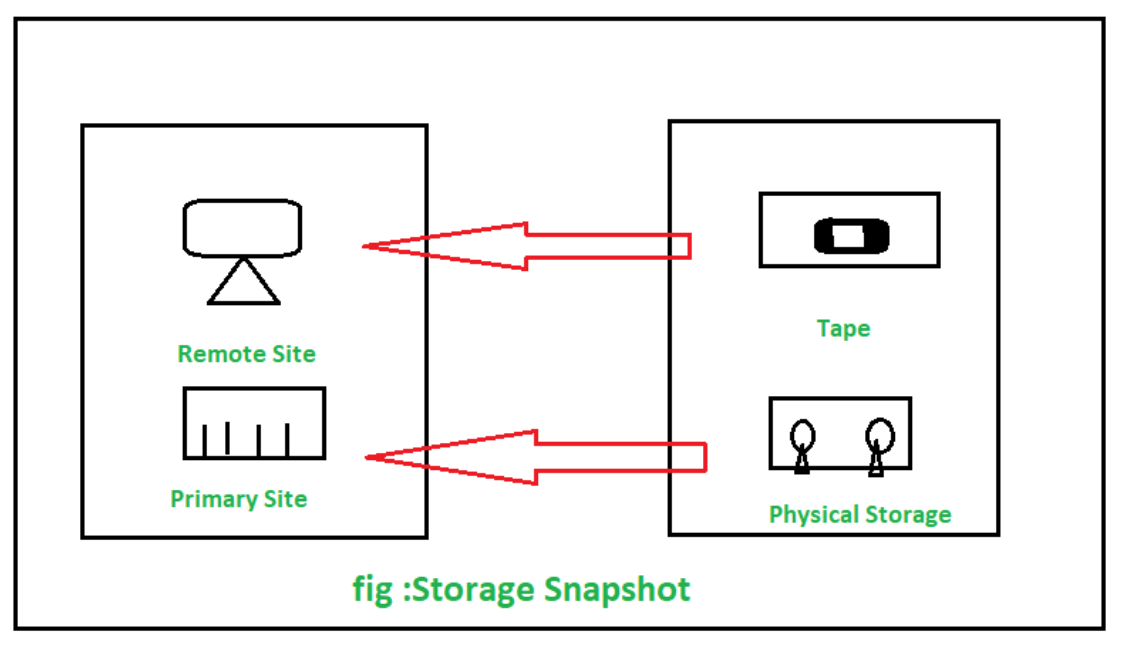Storage Snapshot Technology
Last Updated :
30 Jul, 2020
Storage :
Storage is defined as process/procedure in which digital data is saved within data storage device by means of computing technology. Storage is technology that empower computer to retain data, either temporarily or permanently.
Snapshot :
Snapshot is state of system at particular point of time. It can refer to actual copy of state of system or capability provided by certain systems.Snapshot is often used in photography, it is also computing term that refers to copy made of disk drive at specific moment of time. Snapshots are very useful for backing up data at different intervals, which allows information to be recovered from different periods of time at different managerial level.
Storage Snapshot :
Storage Snapshot provides its preference effective in data storage module, as it offers data protection along with data mining and data cloning also.Many merchants who take round storage hardware and its related software are offering snapshot technique support, as it provides advanced data protection, which is important for mission critical businesses. Storage snapshot provides zero impact backup with minimal or zero application downtime, as it takes up frequent backups. It helps in decreasing data recovery time as it takes up backup of large volumes of data in efficient way, fetching instant recovery from snapshot. A storage snapshot is back-up copy, which is created at particular point of time.

Classification :
Storage snapshots can be classified into three types that are :
1. Copy-on-write –
In this case data is copied into pool of allocated storage. Major limitation of this method is that it impacts performance of original data present.
- A snapshot of storage volume is designed using predesignated space for snapshot. When snapshot is first produced, only meta-data about where original data is stored is copied.
- No corporeal copy of data is done at the time snapshot is produced. For reason, creation of snapshot is almost instantaneous.
- Snapshot copy then tracks modifying blocks on original volume as write to original volume are performed.
- Original data that is being written to is copied into designated storage pool that is set aside for snapshot before original data is overwritten, hence name “copy-on-write”.
2. Redirect-on-write –
This is somewhat similar to copy-on-write. It is providing efficient snapshots in terms of performance and space as it does not deal in double writing.
- This technique is quite similar to copy-on-write method, without double write penalty, and it offers storage space and performance efficient snapshots.
- Current writes to original volume are diverted to another location set aside for snapshot. Primacy of redirecting write is that only one write takes place, whereas with copy-on-write, two writes occur (one to copy original data onto storage space, other to copy changed data).
- Although, with this mechanism original copy accommodate the point-in-time data, that is, snapshot, and changed data reside on snapshot storage. When snapshot is emitted, data from snapshot storage must be reconciled back into original volume.
- Moreover, as different snapshots are designed, access to original data, tracking of data in snapshots and original volume, and reconciliation upon snapshot deletion is further complicated.
- The snapshot be subject to primary copy of data and primary data set can quickly become fragmented.
3. Split mirror –
In this technique, physical clone is made of data which resides on different storage space.
- Split mirror forms physical clone of storage entity, such as file-system, volume, or logical unit number for which snapshot is being created, onto another entity of same kind and exact same size.
- The whole contents of original volume are copied onto separate volume. Clone copies are mostly available, since they are exact duplicates of original volume that resides on separate storage space. Although, due to data copy, such snapshots cannot be created instantaneously. In another way, clone can also be made available instantaneously by “splitting” preexisting mirror of volume into two, with side effect that original volume has one fewer synchronized mirror.
- This snapshot mechanism requires as much storage space as original data for each snapshot. This method has performance overhead of writing concurrently to mirror copy.
Like Article
Suggest improvement
Share your thoughts in the comments
Please Login to comment...